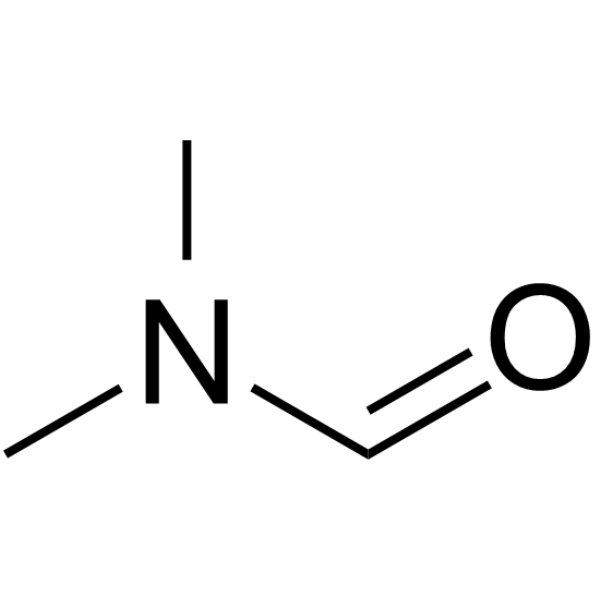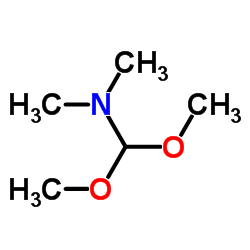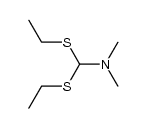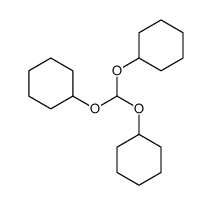Methanamine,1,1-bis(cyclohexyloxy)-N,N-dimethyl-

Methanamine,1,1-bis(cyclohexyloxy)-N,N-dimethyl- structure
|
Common Name | Methanamine,1,1-bis(cyclohexyloxy)-N,N-dimethyl- | ||
|---|---|---|---|---|
| CAS Number | 2016-05-9 | Molecular Weight | 255.39600 | |
| Density | 0.95 | Boiling Point | 115-116ºC(0.75 torr) | |
| Molecular Formula | C15H29NO2 | Melting Point | N/A | |
| MSDS | N/A | Flash Point | 90ºC | |
| Name | n,n-dimethylformamide dicyclohexyl acetal |
|---|---|
| Synonym | More Synonyms |
| Density | 0.95 |
|---|---|
| Boiling Point | 115-116ºC(0.75 torr) |
| Molecular Formula | C15H29NO2 |
| Molecular Weight | 255.39600 |
| Flash Point | 90ºC |
| Exact Mass | 255.22000 |
| PSA | 21.70000 |
| LogP | 3.53020 |
| Vapour Pressure | 0.000596mmHg at 25°C |
| Index of Refraction | n20/D 1.4678(lit.) |
Synonym:1,1-Dicyclohexyloxytrimethylamin Section 2 - COMPOSITION, INFORMATION ON INGREDIENTS
Risk Phrases: 36/37/38 Section 3 - HAZARDS IDENTIFICATION EMERGENCY OVERVIEW
Irritating to eyes, respiratory system and skin.The toxicological properties of this material have not been fully investigated.Moisture sensitive. Potential Health Effects Eye: Causes eye irritation. Skin: Causes skin irritation. Ingestion: May cause gastrointestinal irritation with nausea, vomiting and diarrhea. The toxicological properties of this substance have not been fully investigated. Inhalation: Causes respiratory tract irritation. The toxicological properties of this substance have not been fully investigated. Chronic: No information found. Section 4 - FIRST AID MEASURES Eyes: Immediately flush eyes with plenty of water for at least 15 minutes, occasionally lifting the upper and lower eyelids. Get medical aid. Skin: Get medical aid. Immediately flush skin with plenty of water for at least 15 minutes while removing contaminated clothing and shoes. Wash clothing before reuse. Ingestion: Never give anything by mouth to an unconscious person. Get medical aid. Do NOT induce vomiting. If conscious and alert, rinse mouth and drink 2-4 cupfuls of milk or water. Inhalation: Remove from exposure and move to fresh air immediately. If not breathing, give artificial respiration. If breathing is difficult, give oxygen. Get medical aid. Notes to Physician: Treat symptomatically and supportively. Section 5 - FIRE FIGHTING MEASURES General Information: As in any fire, wear a self-contained breathing apparatus in pressure-demand, MSHA/NIOSH (approved or equivalent), and full protective gear. During a fire, irritating and highly toxic gases may be generated by thermal decomposition or combustion. Will burn if involved in a fire. Use water spray to keep fire-exposed containers cool. Water may be ineffective. Material is lighter than water and a fire may be spread by the use of water. Combustible liquid. Vapors may be heavier than air. They can spread along the ground and collect in low or confined areas. Containers may explode when heated. Extinguishing Media: In case of fire, use water, dry chemical, chemical foam, or alcohol-resistant foam. Use water spray to cool fire-exposed containers. Do NOT get water inside containers. Section 6 - ACCIDENTAL RELEASE MEASURES General Information: Use proper personal protective equipment as indicated in Section 8. Spills/Leaks: Absorb spill with inert material (e.g. vermiculite, sand or earth), then place in suitable container. Clean up spills immediately, observing precautions in the Protective Equipment section. Remove all sources of ignition. Use a spark-proof tool. Provide ventilation. Do not get water inside containers. Section 7 - HANDLING and STORAGE Handling: Wash thoroughly after handling. Remove contaminated clothing and wash before reuse. Use only in a well-ventilated area. Avoid breathing dust, vapor, mist, or gas. Avoid contact with eyes, skin, and clothing. Empty containers retain product residue, (liquid and/or vapor), and can be dangerous. Keep container tightly closed. Keep away from heat, sparks and flame. Avoid ingestion and inhalation. Do not allow contact with water. Do not pressurize, cut, weld, braze, solder, drill, grind, or expose empty containers to heat, sparks or open flames. Keep from contact with moist air and steam. Storage: Keep away from heat, sparks, and flame. Keep away from sources of ignition. Store in a tightly closed container. Store in a cool, dry, well-ventilated area away from incompatible substances. Store protected from moisture. Section 8 - EXPOSURE CONTROLS, PERSONAL PROTECTION Engineering Controls: Facilities storing or utilizing this material should be equipped with an eyewash facility and a safety shower. Use adequate general or local explosion-proof ventilation to keep airborne levels to acceptable levels. Exposure Limits CAS# 2016-05-9: Personal Protective Equipment Eyes: Wear appropriate protective eyeglasses or chemical safety goggles as described by OSHA's eye and face protection regulations in 29 CFR 1910.133 or European Standard EN166. Skin: Wear appropriate protective gloves to prevent skin exposure. Clothing: Wear appropriate protective clothing to prevent skin exposure. Respirators: A respiratory protection program that meets OSHA's 29 CFR 1910.134 and ANSI Z88.2 requirements or European Standard EN 149 must be followed whenever workplace conditions warrant respirator use. Section 9 - PHYSICAL AND CHEMICAL PROPERTIES Physical State: Liquid Color: light yellow Odor: Not available. pH: Not available. Vapor Pressure: Not available. Viscosity: Not available. Boiling Point: 115 - 116 deg C @ .75mm Hg Freezing/Melting Point: Not available. Autoignition Temperature: Not applicable. Flash Point: 90 deg C ( 194.00 deg F) Explosion Limits, lower: Not available. Explosion Limits, upper: Not available. Decomposition Temperature: Solubility in water: Specific Gravity/Density: .9580g/cm3 Molecular Formula: C15H29NO2 Molecular Weight: 255.40 Section 10 - STABILITY AND REACTIVITY Chemical Stability: Stable under normal temperatures and pressures. Conditions to Avoid: Incompatible materials, ignition sources, excess heat, exposure to moist air or water. Incompatibilities with Other Materials: Moisture, strong oxidizing agents, acids. Hazardous Decomposition Products: Nitrogen oxides, carbon monoxide, irritating and toxic fumes and gases, carbon dioxide. Hazardous Polymerization: Has not been reported. Section 11 - TOXICOLOGICAL INFORMATION RTECS#: CAS# 2016-05-9 unlisted. LD50/LC50: Not available. Carcinogenicity: N,N-Dimethylformamide dicyclohexyl acetal - Not listed by ACGIH, IARC, or NTP. Section 12 - ECOLOGICAL INFORMATION Section 13 - DISPOSAL CONSIDERATIONS Dispose of in a manner consistent with federal, state, and local regulations. Section 14 - TRANSPORT INFORMATION IATA Not regulated as a hazardous material. IMO Not regulated as a hazardous material. RID/ADR Not regulated as a hazardous material. Section 15 - REGULATORY INFORMATION European/International Regulations European Labeling in Accordance with EC Directives Hazard Symbols: XI Risk Phrases: R 36/37/38 Irritating to eyes, respiratory system and skin. Safety Phrases: S 24/25 Avoid contact with skin and eyes. WGK (Water Danger/Protection) CAS# 2016-05-9: No information available. Canada None of the chemicals in this product are listed on the DSL/NDSL list. CAS# 2016-05-9 is not listed on Canada's Ingredient Disclosure List. US FEDERAL TSCA CAS# 2016-05-9 is not listed on the TSCA inventory. It is for research and development use only. SECTION 16 - ADDITIONAL INFORMATION N/A |
| Hazard Codes | Xi: Irritant; |
|---|---|
| Risk Phrases | 36/37/38 |
| Safety Phrases | S24/25 |
| HS Code | 2922199090 |
|
~% 
Methanamine,1,1... CAS#:2016-05-9 |
| Literature: Tsakotellis; Johnson; Skinner; Skidmore; Maibach Journal of pharmaceutical sciences, 1971 , vol. 60, # 1 p. 84 - 89 |
|
~% 
Methanamine,1,1... CAS#:2016-05-9 |
| Literature: Costisella,B.; Gross,H. Journal fuer Praktische Chemie (Leipzig), 1977 , vol. 319, p. 8 - 16 |
|
~% 
Methanamine,1,1... CAS#:2016-05-9 |
| Literature: Ivanova,I.A. et al. Bulletin of the Academy of Sciences of the USSR, Division of Chemical Science (English Translation), 1965 , p. 2143 - 2149 Izvestiya Akademii Nauk SSSR, Seriya Khimicheskaya, 1965 , p. 2179 - 2187 |
| HS Code | 2922199090 |
|---|---|
| Summary | 2922199090. other amino-alcohols, other than those containing more than one kind of oxygen function, their ethers and esters; salts thereof. VAT:17.0%. Tax rebate rate:13.0%. . MFN tariff:6.5%. General tariff:30.0% |
| N,N-Dimethyl-formamid-dicyclohexylacetal |
| N,N-dimethylformamide dicyclohexylacetal |
| 1,1-DICYCLOHEXYLOXYTRIMETHYLAMINE |
| dimethylformamide di-cyclohexyl acetal |
| DMF-DCHA |
| Dimethylformamiddicyclohexylacetal |
| EINECS 217-947-2 |
| MFCD00003851 |




 CAS#:89315-61-7
CAS#:89315-61-7